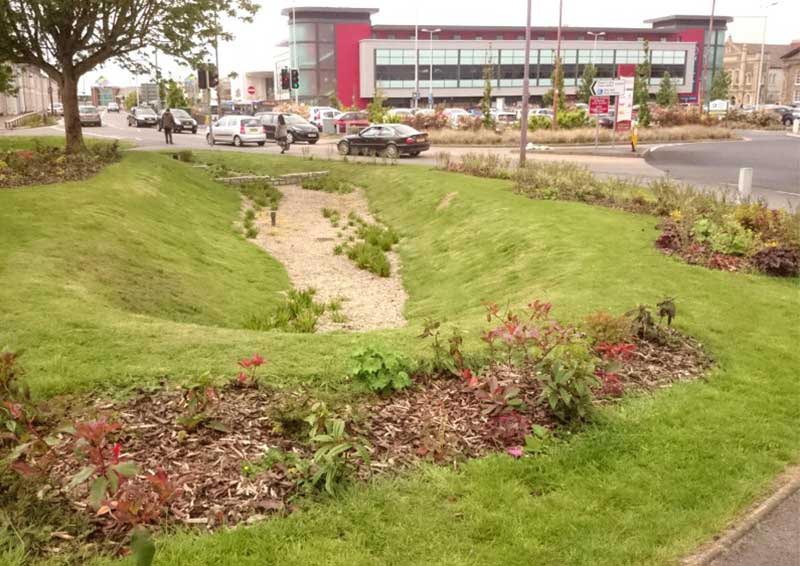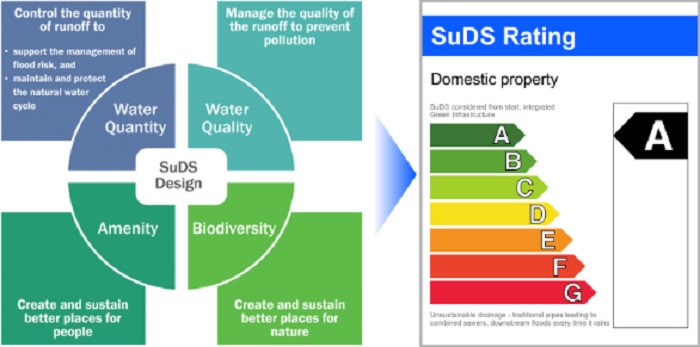SuDS - is there light at the end of the tunnel?

|
| After over a decade of inaction, it looks like SuDS may be going mainstream. A recent ICE 'Design Sprint' workshop in Leeds looked at what could be done to encourage uptake. Landscape architect Bill Blackledge gives a personal view. |
Contents |
[edit] Introduction
Sustainable urban drainage (SuDS) is widely recognised as an essential part of the toolkit needed to make our cities liveable, even bearable, in the decades to come. Look out UK - 21°C in February?
The purpose of the ICE Design Sprint was to help make SuDS the norm, not the exception, but why was it even needed?
[edit] A brief history of UK SuDS
Following the devastating floods of 2007, the 2008 Pitt Review sought answers. The resulting 2010 Flood and Water Management Act (FWMA) set out Schedule 3 to overcome the biggest barrier to SuDS implementation - adoption.
During the course of the coalition government (2010 - 2014), Schedule 3 was consulted, delayed and dissipated, until finally, at the start of 2015, it was completely neutered.
In an effort to abolish any 'hindrances' to housebuilding, SuDS would not be required for developments of less than 10 houses and, in any case, only where "reasonably practical".
No standards or regulatory systems were created that might have forced any reconsideration of entrenched and blinkered attitudes. It provided a get-out for unwilling developers and their consultants, who were, and sadly largely still are, reluctant to do anything other than conventional piped drainage systems, with massive plastic tanks or hideous bomb craters at the low end.
There are, of course, some obvious pointers to better practice, and some shining examples of a better way. They tend to win awards, and are regarded as exceptions.
So, how can we make excellent SuDS more commonplace?
[edit] The ICE Leeds Design Sprint
The Sprint was just that, a quick dash through the issues around SuDS and how practical support might be encouraged.
It was an opportunity to talk with a wide cross-section of construction industry professionals, developers, local authority officers and industry experts to find common ground in our thinking.
The key aim was to find ways to make good SuDS (i.e. CIRIA design principles) the norm, not the exception.
Four teams were allocated a perspective from which to consider the issues: a family (affected by flooding but wary of SuDS features in a new development they were thinking about moving to); a lead local flood authority manager; a water and sewerage company asset manager, and a developer.
The common message to come from each team was that greater awareness - of climate change, water-related issues and the role of SuDS - could help to drive demand from the consumer end of the development chain.
In the same way that action on plastic waste has been driven by consumer reaction to hard-hitting messages (from the likes of David Attenborough), so consumers, together with people in all of the above roles, need to realise what we are facing and how to respond.
Participants initially made proposals in pairs, based on insights derived from one of the four perspectives; a total of 20 proposals were made at this stage.
One of the most interesting insights was that there's little incentive for housing developers to make the effort to implement SuDS (I won't say spend the extra money - enough studies have shown that SuDS are cost-neutral or cheaper than conventional approaches). Several proposals focused on this issue.
So, how about a rating scheme (like the well-established energy efficiency ratings A-G), which shows how well a particular development has embraced SuDS design? The parameters could be based on the key criteria of CIRIA 2015 - early implementation of SuDs in the design process, embracing water quality, water quantity, amenity and biodiversity.

|
| A simple model for communicating SuDS performance, based on CIRIA principles |
[edit] Is there light at the end of the tunnel?
Yes. Everyone can unite around CIRIA's excellent 2015 SuDS Design Manual, and the Leeds Design Sprint showed some of the ways this could be achieved.
There are some fabulous SuDS projects: Llanelli and London in the UK; China's headline-grabbing 'sponge cities'; ground-breaking US storm-water design (Portland); excellent Scandinavian, Dutch and German urban design - all globally promoting landscape-based SuDS as the way to create beautiful, resilient cities.
Scotland has long been ahead of the game, through SEPA and Sewers for Scotland (2007). The Welsh government has boldly implemented Schedule 3 of the FWMA – ready or not – just do it. Momentum is growing.
And what of England? 'Sewers for Adoption 8' (SfA8) is the closest we have to a real light at the end of the tunnel.
In the near future, due to an expanded definition of adoptable sewers to include SuDs features, this should provide a mechanism for adopting compliant SuDS assets. It doesn't sound glamorous, but it could be a critical step in finally making SUDs the norm, not the exception.
After a journey of more than a decade, full of setbacks and disappointments, are we nearly there? I think so.
[edit] About this article
This article was written by Bill Blackledge, Managing Director of 2B Landscape Consultancy and Vice Chair of the Landscape Institute Technical Committee. It first appeared on the website of the Institution of Civil Engineers (ICE) and can be accessed here.
[edit] Related articles on Designing Buildings Wiki
- Blackwater.
- Blue roof.
- BREEAM Surface water run-off.
- Catchment flood management plans.
- Dewatering.
- Drainage.
- Eutrophication.
- Flood.
- Flood and Water Management Act.
- Flood insurance.
- Flood risk.
- Flood risk management plan.
- Future flood prevention.
- Future Water, The Government’s water strategy for England.
- Greywater.
- Groundwater control in urban areas.
- Highway drainage.
- ICE articles on Designing Buildings Wiki.
- Pitt Review.
- Planning for floods.
- Pumps and dewatering equipment.
- Rainwater harvesting.
- River engineering.
- Sewer construction.
- Sewerage.
- Soakaway.
- SuDS infographic.
- Sustainable urban drainage systems - latest guidance.
- Sustainable water.
- The SuDS Manual.
- Water Act 2014.
- Water consumption.
- Water engineering.
- Water transfers and interconnections.
[edit] External references
Featured articles and news
RTPI leader to become new CIOB Chief Executive Officer
Dr Victoria Hills MRTPI, FICE to take over after Caroline Gumble’s departure.
Social and affordable housing, a long term plan for delivery
The “Delivering a Decade of Renewal for Social and Affordable Housing” strategy sets out future path.
A change to adoptive architecture
Effects of global weather warming on architectural detailing, material choice and human interaction.
The proposed publicly owned and backed subsidiary of Homes England, to facilitate new homes.
How big is the problem and what can we do to mitigate the effects?
Overheating guidance and tools for building designers
A number of cool guides to help with the heat.
The UK's Modern Industrial Strategy: A 10 year plan
Previous consultation criticism, current key elements and general support with some persisting reservations.
Building Safety Regulator reforms
New roles, new staff and a new fast track service pave the way for a single construction regulator.
Architectural Technologist CPDs and Communications
CIAT CPD… and how you can do it!
Cooling centres and cool spaces
Managing extreme heat in cities by directing the public to places for heat stress relief and water sources.
Winter gardens: A brief history and warm variations
Extending the season with glass in different forms and terms.
Restoring Great Yarmouth's Winter Gardens
Transforming one of the least sustainable constructions imaginable.
Construction Skills Mission Board launch sector drive
Newly formed government and industry collaboration set strategy for recruiting an additional 100,000 construction workers a year.
New Architects Code comes into effect in September 2025
ARB Architects Code of Conduct and Practice available with ongoing consultation regarding guidance.
Welsh Skills Body (Medr) launches ambitious plan
The new skills body brings together funding and regulation of tertiary education and research for the devolved nation.
Paul Gandy FCIOB announced as next CIOB President
Former Tilbury Douglas CEO takes helm.
UK Infrastructure: A 10 Year Strategy. In brief with reactions
With the National Infrastructure and Service Transformation Authority (NISTA).























